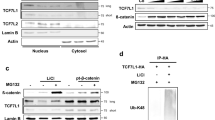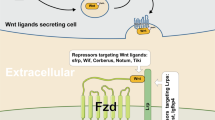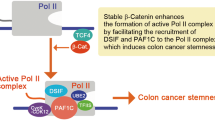Abstract
Deregulation of the pRb/E2F or Wnt/β-catenin pathway occurs frequently in human cancers, which is often associated with inappropriate cell proliferation. Although the oncogenic roles of pRb/E2F1 and Wnt/β-catenin pathways have been well studied, the functional interaction between the two pathways has only recently been characterized. In particular, E2F1 has been recently reported to negatively regulate Wnt/β-catenin activity in human colorectal cancers, though the mechanism underlying this regulation is not fully understood. Here we provide evidence that β-catenin interacting protein 1 (CTNNBIP1), also known as ICAT (inhibitor of β-catenin and TCF4), functions as a crucial node to mediate the cross talk between E2F1 and β-catenin signaling. We show that ICAT is a direct transcriptional target of E2F1, and that activation of ICAT by E2F1 is required for E2F1 to inhibit β-catenin activity. This study provides a mechanistic insight into the antagonistic interaction between E2F1 and β-catenin signaling.
This is a preview of subscription content, access via your institution
Access options
Subscribe to this journal
Receive 50 print issues and online access
$259.00 per year
only $5.18 per issue
Buy this article
- Purchase on Springer Link
- Instant access to full article PDF
Prices may be subject to local taxes which are calculated during checkout




Similar content being viewed by others
References
Bernards R . (2008). Cancer: entangled pathways. Nature 455: 479–480.
Bracken AP, Pasini D, Capra M, Prosperini E, Colli E, Helin K et al. (2003). EZH2 is downstream of the pRB-E2F pathway, essential for proliferation and amplified in cancer. EMBO J 22: 5323–5335.
Bramis J, Zacharatos P, Papaconstantinou I, Kotsinas A, Sigala F, Korkolis DP et al. (2004). E2F-1 transcription factor immunoexpression is inversely associated with tumor growth in colon adenocarcinomas. Anticancer Res 24: 3041–3047.
Cadigan KM . (2008). Wnt-beta-catenin signaling. Curr Biol 18: R943–R947.
Clevers H . (2006). Wnt/beta-catenin signaling in development and disease. Cell 127: 469–480.
Firestein R, Bass AJ, Kim SY, Dunn IF, Silver SJ, Guney I et al. (2008). CDK8 is a colorectal cancer oncogene that regulates beta-catenin activity. Nature 455: 547–551.
Iaquinta PJ, Lees JA . (2007). Life and death decisions by the E2F transcription factors. Curr Opin Cell Biol 19: 649–657.
Kim SM, Choi EJ, Song KJ, Kim S, Seo E, Jho EH et al. (2009). Axin localizes to mitotic spindles and centrosomes in mitotic cells. Exp Cell Res 315: 943–954.
Klaus A, Birchmeier W . (2008). Wnt signalling and its impact on development and cancer. Nat Rev Cancer 8: 387–398.
Logan CY, Nusse R . (2004). The Wnt signaling pathway in development and disease. Annu Rev Cell Dev Biol 20: 781–810.
Moon RT, Kohn AD, De Ferrari GV, Kaykas A . (2004). WNT and beta-catenin signalling: diseases and therapies. Nat Rev Genet 5: 691–701.
Morris EJ, Ji JY, Yang F, Di Stefano L, Herr A, Moon NS et al. (2008). E2F1 represses beta-catenin transcription and is antagonized by both pRB and CDK8. Nature 455: 552–556.
Nahle Z, Polakoff J, Davuluri RV, McCurrach ME, Jacobson MD, Narita M et al. (2002). Direct coupling of the cell cycle and cell death machinery by E2F. Nat Cell Biol 4: 859–864.
Nevins JR . (2001). The Rb/E2F pathway and cancer. Hum Mol Genet 10: 699–703.
Polager S, Ginsberg D . (2008). E2F—at the crossroads of life and death. Trends Cell Biol 18: 528–535.
Polakis P . (2007). The many ways of Wnt in cancer. Curr Opin Genet Dev 17: 45–51.
Sherr CJ, McCormick F . (2002). The RB and p53 pathways in cancer. Cancer Cell 2: 103–112.
Tago K, Nakamura T, Nishita M, Hyodo J, Nagai S, Murata Y et al. (2000). Inhibition of Wnt signaling by ICAT, a novel beta-catenin-interacting protein. Genes Dev 14: 1741–1749.
Tan J, Zhuang L, Jiang X, Yang KK, Karuturi KM, Yu Q et al. (2006). Apoptosis signal-regulating kinase 1 is a direct target of E2F1 and contributes to histone deacetylase inhibitor-induced apoptosis through positive feedback regulation of E2F1 apoptotic activity. J Biol Chem 281: 10508–10515.
Vigo E, Muller H, Prosperini E, Hateboer G, Cartwright P, Moroni MC et al. (1999). CDC25A phosphatase is a target of E2F and is required for efficient E2F-induced S phase. Mol Cell Biol 19: 6379–6395.
Wu ZL, Zheng SS, Li ZM, Qiao YY, Aau MY, Yu Q et al. (2010). Polycomb protein EZH2 regulates E2F1-dependent apoptosis through epigenetically modulating Bim expression. Cell Death Differ 17: 801–810.
Xie W, Jin L, Mei Y, Wu M . (2009). E2F1 represses beta-catenin/TCF activity by direct up-regulation of Siah1. J Cell Mol Med 13: 1719–1727.
Zhao Y, Tan J, Zhuang L, Jiang X, Liu ET, Yu Q et al. (2005). Inhibitors of histone deacetylases target the Rb-E2F1 pathway for apoptosis induction through activation of proapoptotic protein Bim. Proc Natl Acad Sci USA 102: 16090–16095.
Acknowledgements
We thank Dr Kristian Helin (European Institute of Oncology, Milan) for the ER-E2F1 plasmids and Dr Claudio Brancolini for providing the IMR90/E1A cells. This work was supported by the Agency for Science, Technology and Research of Singapore.
Author information
Authors and Affiliations
Corresponding author
Ethics declarations
Competing interests
The authors declare no conflict of interest.
Rights and permissions
About this article
Cite this article
Wu, Z., Zheng, S., Li, Z. et al. E2F1 suppresses Wnt/β-catenin activity through transactivation of β-catenin interacting protein ICAT. Oncogene 30, 3979–3984 (2011). https://doi.org/10.1038/onc.2011.129
Received:
Revised:
Accepted:
Published:
Issue Date:
DOI: https://doi.org/10.1038/onc.2011.129
Keywords
This article is cited by
-
Knockout of ICAT in Adipose Tissue Alleviates Fibro-inflammation in Obese Mice
Inflammation (2023)
-
MicroRNA-9 facilitates hypoxia-induced injury and apoptosis in H9c2 cells via targeting CDK8
Journal of Biosciences (2021)
-
Transcription factor E2F1 promotes EMT by regulating ZEB2 in small cell lung cancer
BMC Cancer (2017)
-
CDK8 regulates E2F1 transcriptional activity through S375 phosphorylation
Oncogene (2013)
-
The Diagnostic, Prognostic, and Predictive Potential of MicroRNA Biomarkers in Colorectal Cancer
Current Colorectal Cancer Reports (2012)



